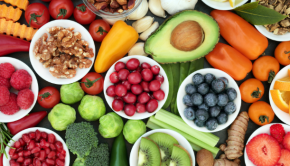Good Food on a Tight Budget
Tips to Get Top Value from Each Dollar
For many, the recent economic downturn has affected the way we shop for food. Even families that cook dinner at home most nights are struggling to afford the ingredients to make healthy meals, says Laura Seman, a senior manager for Cooking Matters, a national program that educates families in need about reaping the most from local food resources.
“Putting good food on the family table on a five-or-six-dollar-a-day per person budget is tough, but it’s possible,” advises Nutritionist Dawn Undurraga, a registered dietitian and co-author of the Environmental Working Group’s online publication, Good Food on a Tight Budget. “Even eating for one is doable for under $200 a month. When you fill your cart with the foods listed, you’re building health, lowering exposure to agricultural chemicals, protecting the environment and cutting grocery bills.”
In considering how consumers can maximize nutritional value in their spending, researchers examined 1,200 foods to help people get beyond the common perception that eating healthy is expensive. “We looked at food prices, nutrients, pesticides, environmental pollutants and artificial ingredients,” says Undurraga. “Then we chose the top 100 or so, based on balancing all of those factors.”
Think Outside the Box
Some of the EWG findings might surprise many of us:
- Raw cabbage is the top-ranked food because of its price and high nutritional value as a cruciferous vegetable. For less than 10 cents a serving, it poses far fewer calories than potatoes and is a worthy addition to salads, soups and stir-fries.
- The next highest marks for price and nutrition spotlight carrots, bananas, pears, watermelon and frozen broccoli, each at less than 30 cents a serving.
- Bananas and pears usually cost less than apples, plus they customarily endure fewer pesticide applications.
- The best animal protein award goes to roasted turkey; hot dogs ranked last.
- The next-best animal protein identified is a whole chicken, roasted at the beginning of the week and used in various ways for future meals.
- Fresh, whole carrots and sweet potatoes are among the best produce buys, but frozen corn and broccoli almost always cost less than their fresh equivalents and are just as nutritious.
- A serving of oatmeal is half the cost of sugary processed cereals, plus it’s more filling and causes less fluctuation in blood sugar levels.
- Canned salmon is almost always wild caught and is much cheaper than fresh, but be wary of BPA (bisphenol-A) migration from the can.
- Queso blanco, a mild, soft, white cheese common in Latino cooking, is both less expensive and less processed than many other cheeses.
Change Our Routine
Tracie McMillan, of Ann Arbor, Michigan, author of the bestselling book, The American Way of Eating, learned how to eat on a tight budget as an undercover journalist. She had to budget for food based on wages working on a farm in California, in the produce department of a Michigan superstore and in a New York City restaurant kitchen. The task was even more difficult because she was determined to eat as healthy as possible.
“Time and energy are key ingredients when cooking from scratch,” says McMillan. “I was exhausted after a day spent working these physically demanding jobs and quickly became more apathetic about healthy food than I generally am.”
Without disposable funds for the fast-food route, cooking from scratch was mandatory. She learned how to soak beans overnight, cook a large pot of them and freeze helpings to reheat later. The cost was about 50 cents a meal, compared with $3 for two or three servings from a can.
Eggs, brown rice and sweet potatoes became an important—and healthy—part of her weekly diet. McMillan also gained a lasting affection for roasted vegetables, both as part of meals and as snacks. “I just cut up a couple of sweet potatoes, add some broccoli or beans or whatever is cheap at the supermarket or farmers’ market, toss in a tablespoon of olive oil and I’m set for two or three days,” she says. Also, “I learned to use meat more as a seasoning than as a main course.”
Find more tips and pages of recipes at ewg.org/goodfood.
Read More: Eat Well, Spend Less




























